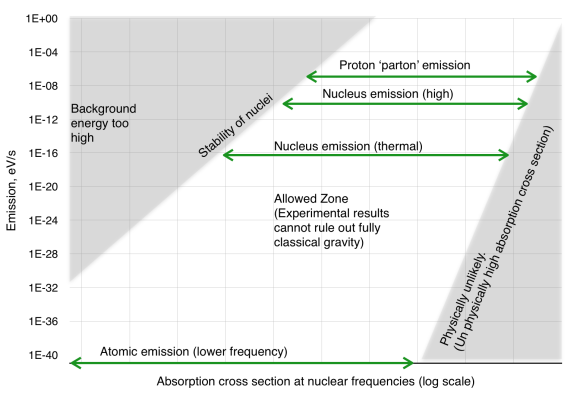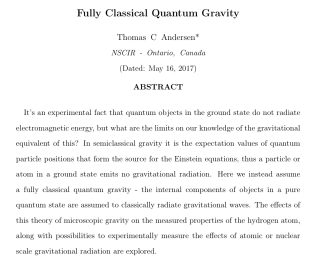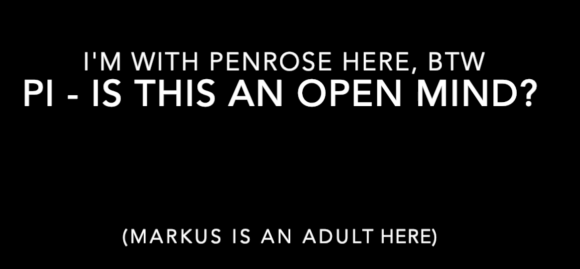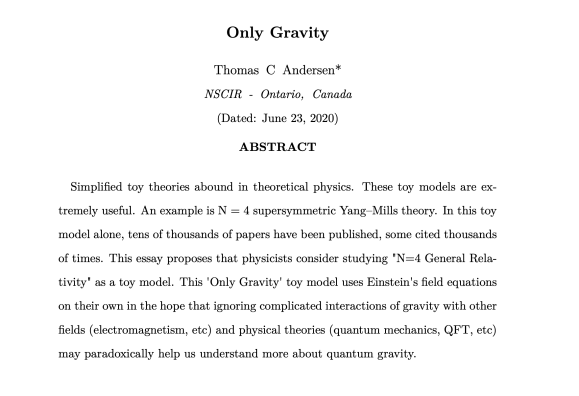Emergent quantum mechanics comes in many forms: stochastic electrodynamics (
Ana María Cetto) , de Broglie – Bohmian mechanics (
John W M Bush) , thermal models (
Gerhard Groessing ) etc. In many of these forms of emergent quantum mechanics, particles have a physical existence and experience sub quantal movement. The paper I have just posted looks at the gravitational consequences of this sub quantal motion. An interesting finding is that while a classical Bohr hydrogen atom has a lifetime of about 10^-11 seconds, it would take that same atom 10^40 seconds or so to radiate away a few eV of energy. This indicates that the stability of the atoms is
not an indication that gravity needs to be quantized, which is antithetical to Einstein in 1916:
- “…Nevertheless, due to the inner-atomic movement of electrons, atoms would have to radiate not only electro-magnetic but also gravitational energy, if only in tiny amounts. As this is hardly true in Nature, it appears that quantum theory would have to modify not only Maxwellian electrodynamics, but also the new theory of gravitation.” – Einstein, 1916
Einstein it would seem was wrong on the gravtitational side of this.
The paper looks at possible ways to see these tiny emissions (nuclear scale emissions are higher) and thus lays out a quantum gravity experiment achievable with today’s technology.

The experimental parameter space. Most important thing to note is that this is a quantum gravity experiment with an achievable parameter space!
Here is the paper…
Also see these references…







 Andersen, T. C. on ORCID
Andersen, T. C. on ORCID




classical and quantum are contradictory terms.
Emergent Quantum Mechanics suggests that one can build quantum mechanics out of a classical underlying system, so I don’t think they are contradictory.
What has been named “classical” is not consistent. “Classical” has been deemed synonymous with overpast, obsolete dynamics theory. Different succeeding theories have all abandoned some of the properties of classical theory, whilst keeping others. Authors have thus accused their competitors of continuing to adopt a classical explanation, mostly as a cheap argument. Copenhagen theory, for example, assumes the notion that movement can occur without trajectory, and that at some point called wavefunction collapse, these bizarre trajectories become classical, discrete particle dynamics. In a sense, this “quantum” theory is very classical. On the other hand, you have theories like many-worlds, which scrap consistent history, but keeps classical trajectories; or bohmian mechanics, which scraps locality but keeps trajectories and determinism. Every non-classical theory is half-classical. Authors frequently use the word “classical” as an elegant way of accusing a theory of being outdated and wrong. One day, all of the theories which are today deemed cutting-edge, will be deemed classical. What is or isn’t “classical” depends, ironically, on the reference frame.
This book will elaborate more:https://www.amazon.com/EXCEPTIONALLY-SIMPLE-QUANTUM-THEORY-GRAVITY/dp/1521543054/ref=sr_1_1?s=books&ie=UTF8&qid=1497953756&sr=1-1